
Theodore Frank Snyder (August 15, 1881 to July 16, 1965) | |
 Compositions Compositions | |
|
1904
Rustling SilksThere Must Be Somethin' the Matter with Me [1] The Man in the Moon was Wise [1] The Goblin Man [1] Here's My Friend [1] Heinie [1] I Wonder If You Miss Me as I Miss You [1] 1905
Nothin' from Nothin' Leaves You [1]Take a Car [1] 1906
I'd Rather Be Outside a-Lookin' In Than on theInside a-Lookin' Out [w/Fred J. Hamill] Bonnie Jean [2] Moses Andrew Jackson, Good-Bye [w/Ren Shields] 1907
There's a Girl in the World for Every Boy anda Boy for Every Girl [w/Will D. Cobb] Blue Bird: Intermezzo Give Me Your Love [3] 1908
Wild Cherries RagMove On Mr. Moon [1] I Walked Around [1] If You Cared For Me as I Cared for You [1] It's the Pretty Things You Say [2] There'll Come a Day [2] I'm in Love with the Man in the Moon [2] Grandma [2] Make Me Laugh [2] My Wild Deer (Dear) [2] Hugo, If You Go I'm Going Too [4] When the Humming Birds Return, Sweet Irene [4] My Dream of the U.S.A. [5] Broadway Belles [w/Julian Eltinge] Say No! That's All [Frank J. Conroy] 1909
Carnival Maid: MarchRoses and Memories [3] Ogalalla (Indian Love Song) [6] The Star, the Rose and the Dream [w/Albert Lang] When Other Hearts have Closed their Doors [w/Benjamin F. Barnett] I'm Going To Do What I Please [2] Oh, What I'd Do For a Girl Like You Could You Grow Fond of a Nice Young Blonde, If You Loved a Sweet Brunette? [3] My Bambazoo [w/Norman Stadiger] Dancing Sunshine I'm the Kid That Opens Up and Closes Broadway [7] Beautiful Eyes [7,8] McElwee [8] Where Do We Go From Here, Bill? [8] When He Sings the Songs My Mother Sang to Me [w/William Gould] 1911
Ramshackle RagEight Little Letters Make Three Little Words (I Love You) [9] My Bill from Louisville [w/Al Bernard & Willie Weston] He's Coming Back I'll Give a Penny for Your Thoughts [w/Sam M. Lewis] In the Land of Harmony [9] Cancel That Wedding March [w/Artie Hall] [9] Movin' Man Don't Take My Baby Grand [9] June Honeymoon: Walta Caprice I'd Like to Call You Sweetheart [w/Paul Cunningham] 1912
The Ghost of The Violin [9]1914
I Can't Stop Loving You Now [9,10]Moonlight on the Rhine [9,10] The Rose That Will Never Die 1915
I Work Eight Hours (Sleep Eight Hours, ThatLeaves Eight Hours for Love). [9,10] That Soothing Symphony [w/Will J. Harris] 1916
I Was Never Nearer Heaven in My Life [10,11]1917
In San DomingoPaddle Addle in Your Little Canoe Meet Me At The Station, Dear [12] In the Old Red School [w/Joe Goodwin] 1918
I Wonder Why She Kept on Saying "Si, Si,Si, Si, Si, Senor" [12] How'd You Like to Be My Daddy? [12] 1919
Teddy (for the Motion Picture)[w/William J. McKenna] Once in a While [12] In Ding Dong Land [12] I'm Sorry I Ain't Got It, You Could Have It if I Had It Blues [12] No Wonder All the World's in Love with You [13] If I Could Live Life Over (I'd Live it All for You) [w/Jack Wells] It Took Nineteen Hundred and Nineteen Years to Make a Girl Like You [w/Frank Tannenhill] The Water's Fine: Revue [12] Jazzin' the Alphabet I'm in Love with You Shadows Always Make Me Blue The Way to Win a Girl Boys are Like Wonderful Toys With a Little Bit of Cider Inside of Ida, Ida was Full of Ideas 1921
The Sheik of ArabyI Wonder If You Still Care For Me? [13] My Cherry Blossom [13,14] 1922
One Night in June [14] [w/Ernest Klapholz]Stolen Kisses [15] Dancing Fool [13,14] Egyptian Rose [13,15] By the Sapphire Sea [13,15] 1923
Who's Sorry Now [9] [w/Harry Ruby]Bella Donna (Beautiful Lady) [13] [w/Arthur M. Brilant] |
1923 (Cont)
You Gave Me Your Heart (So I'll Give YouMine) [13,15] Fashions of 1924: Revue [13] Bring on the Girls Passing Fancies Underneath the Table Kitty Kay Stepping Just a Little Bit of Love The Tea Garden In the Days of Long Ago Indu-Chi (Corticelli) Two Little Girls and a Boy The Dancing Daily Dozen One Last Waltz Love Through the Ages Miss Whoozis and Mr. Watchaname 1924
Whisper to the Rose [13,15](All Alone With You) In a Little Rendezvous [12] Maybe She'll Write Me, Maybe She'll Phone Me [w/Roy Turk & Fred E. Ahlert] 1925
The Rose of St. Mary's [2]1927
It Was Only A Sun Shower [15,16]Summertime Sweethearts [15,16] Roam On, My Little Gypsy Sweetheart [15,16] The Beggar [15,16] For My Baby [15,16] Under the Moon (Yoo-oo-oo-oo) [15] 1928
That Night in Araby [w/Billy Rose]My Cradle of Dreams [w/Preston Sturges] 1929
For Someone I Love [w/Benny Davis]The Load is Heavy and I'm Ready to Go [8] 1930
To Whisper, Dear, I Love You [17]With My Guitar and You [17,18] Shoo the Hoodoo Away [17] 1931
The Temptations of 1930: RevueFaithfully Yours [19] 1932
(Back Home Among the) Carolina PinesUnder the Moon Talking to You About Me [17] [w/Nick Kenny] 1935
I Marched Around Again [1]I've Got a Notion [w/Alva M. Snyder] 1940
Oo-oo-oo A Hula-hula Moonlight [20]All American [w/J. Keirn Brennan] Composed with Irving Berlin
Wild Cherries Rag (Song)1909 Christmas-Time Seems Years and Years Away If I Thought You Wouldn't Tell Some Little Something About You I Wish That You Was My Gal, Molly No One Could Do It Like My Father Oh! Where is My Wife Tonight? [8] Next to Your Mother, Who Do You Love? Stop That Rag (Keep On Playing, Honey) Do Your Duty Doctor (Oh! Doctor) She Was A Dear Little Girl My Wife's Gone to the Country! [8] Someone Just Like You, Dear Good-Bye Girlie (and Remember Me) 1910
Alexander and His ClarinetColored Romeo Call Me Up Some Rainy Afternoon Thank You, Kind Sir! Said She Kiss Me, My Honey, Kiss Me How Can You Love Such a Man? Dreams, Just Dreams Herman, Let's Dance That Beautiful Waltz Oh, How That German Could Love Sweet Italian Love Bring Back My Lena to Me If the Managers Only Thought the Same as Mother Sweet Marie, Make-a Rag-a-time Dance Wid Me I'm A Happy Married Man I'm Going on a Long Vacation Oh! That Beautiful Rag Piano Man Is there Anything Else I Can Do For You? Wishing Dear Mayme, I Love You! When I Hear You Play That Piano, Bill! I Love You More Each Day That Opera Rag 1911
That Mysterious RagSpanish Love [6] After the Honeymoon Sombrero Land [21] Down to the "Folies Bergere" 1912
Come Back to Me, My MelodyTake a Little Tip From Father I Want To Be In Dixie
1. w/Ed Rose
2. w/Alfred Bryan 3. w/Monroe H. Rosenfeld 4. w/Edgar T. Farran 5. w/Leonard Chick & Charles Roth 6. w/Vincent Bryan 7. w/Carter De Haven 8. w/George Whiting 9. w/Bert Kalmar 10. w/Edgar Leslie 11. Grant Clarke 12. w/Sam M. Lewis & Joe Young 13. w/Harry B. Smith 14. w/Arthur Lange 15. w/Francis Wheeler 16. w/Irving Kahal 17. w/Mort Harris 18. w/Edward Heyman 19. w/Abe Lyman & JamesBrockman 20. w/Irving Bibo 21. w/E. Ray Goetz |
Ted Snyder was born in Freeport, Illinois to Phillip Snyder and Anna Mary Billerbeck, followed by his sister Lillian Snyder five years later (7/1886). The 1900 enumeration showed that the elder Snyders were born in Louisiana, but they were actually from New York and Missouri respectively. When Ted was around 6, the family moved across the border to Boscobel, Wisconsin where he attended public school. His mother and sister started a vaudeville act around 1893 when Lillian was 7 and Ted was 12. He played the piano while they sang and danced.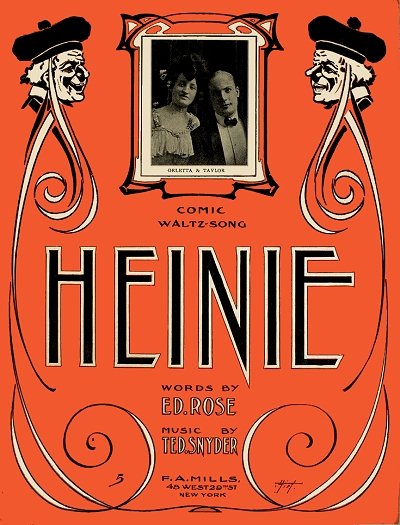 By 1900 the family had moved to Chicago, Illinois, without his father as Phillip had died in 1895.
By 1900 the family had moved to Chicago, Illinois, without his father as Phillip had died in 1895.
 By 1900 the family had moved to Chicago, Illinois, without his father as Phillip had died in 1895.
By 1900 the family had moved to Chicago, Illinois, without his father as Phillip had died in 1895.Snyder's earliest foray into show business came in the form of a job posting theater bills around town. After high school he got work as a café pianist. Pretty soon he was doing minor arranging and composing as a staff pianist for a Chicago firm. While still in Chicago, one of his pieces composed with his lyricist partner Ed Rose made it to Broadway. The Goblin Man was featured in A Venetian Romance, a less than successful show that ran for 28 performances. But it was an encouraging start. Many of the partner's songs were put into print by Frederick A. Mills in New York.
After he had a handful of other pieces published by Mills while still living in Chicago, Snyder moved to New York City around 1906. The amicable 6 foot tall musician had also gotten married in Manhattan to French-born actress Leones Hope Spaezeh on June 22, 1906. In 1907 he began to publish with Rose under the imprint of Rose & Snyder Company, based in Tin Pan Alley at 42 West 28th Street, an address recently vacated by composer and publisher Harry Von Tilzer. During that time Snyder divided his time between New York and Chicago, largely representing the firm's Illinois office. Ted and Ed's business relationship hit a wall in a less than harmonic manner in a courtroom in 1908. After a string of non-hits, Snyder decided to go into the publishing business by himself. There were a few solo attempts at composition early on, but the bulk of his work was as a composer working with other lyricists.
Sometimes an underestimated talent as a composer, Snyder proved himself early on by writing a hit rag, Wild Cherries.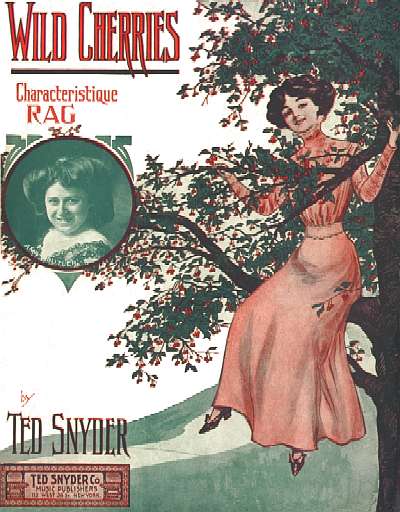 Soon after the success of his big hit, he formed a self-named publishing house with a silent partner and financial backer, Henry Waterson. Henry had first met Snyder when he was barely making a living as a pianist and fledgling publisher. However, he saw the enterprising spirit and energy in Ted, so he helped him get a fresh start in the business while standing quietly in the background as a guiding financial force. The Ted Snyder Company opened in June 1908 at in the Crown Building at 112 West 38th Street, halfway between the current Tin Pan Alley and the future Broadway district publishing center. That building was owned by the Crown Publishing Company, of which Waterson was a director. It also housed a secondary publisher that Snyder was involved with, Seminary Music, who issued some of Scott Joplin's rags in 1908 and 1909. Ted and Ed Rose must have reconciled, since Rose was working in Snyder's professional department at the new location. By November 1908, they were expanding operations to another floor in the building.
Soon after the success of his big hit, he formed a self-named publishing house with a silent partner and financial backer, Henry Waterson. Henry had first met Snyder when he was barely making a living as a pianist and fledgling publisher. However, he saw the enterprising spirit and energy in Ted, so he helped him get a fresh start in the business while standing quietly in the background as a guiding financial force. The Ted Snyder Company opened in June 1908 at in the Crown Building at 112 West 38th Street, halfway between the current Tin Pan Alley and the future Broadway district publishing center. That building was owned by the Crown Publishing Company, of which Waterson was a director. It also housed a secondary publisher that Snyder was involved with, Seminary Music, who issued some of Scott Joplin's rags in 1908 and 1909. Ted and Ed Rose must have reconciled, since Rose was working in Snyder's professional department at the new location. By November 1908, they were expanding operations to another floor in the building.
 Soon after the success of his big hit, he formed a self-named publishing house with a silent partner and financial backer, Henry Waterson. Henry had first met Snyder when he was barely making a living as a pianist and fledgling publisher. However, he saw the enterprising spirit and energy in Ted, so he helped him get a fresh start in the business while standing quietly in the background as a guiding financial force. The Ted Snyder Company opened in June 1908 at in the Crown Building at 112 West 38th Street, halfway between the current Tin Pan Alley and the future Broadway district publishing center. That building was owned by the Crown Publishing Company, of which Waterson was a director. It also housed a secondary publisher that Snyder was involved with, Seminary Music, who issued some of Scott Joplin's rags in 1908 and 1909. Ted and Ed Rose must have reconciled, since Rose was working in Snyder's professional department at the new location. By November 1908, they were expanding operations to another floor in the building.
Soon after the success of his big hit, he formed a self-named publishing house with a silent partner and financial backer, Henry Waterson. Henry had first met Snyder when he was barely making a living as a pianist and fledgling publisher. However, he saw the enterprising spirit and energy in Ted, so he helped him get a fresh start in the business while standing quietly in the background as a guiding financial force. The Ted Snyder Company opened in June 1908 at in the Crown Building at 112 West 38th Street, halfway between the current Tin Pan Alley and the future Broadway district publishing center. That building was owned by the Crown Publishing Company, of which Waterson was a director. It also housed a secondary publisher that Snyder was involved with, Seminary Music, who issued some of Scott Joplin's rags in 1908 and 1909. Ted and Ed Rose must have reconciled, since Rose was working in Snyder's professional department at the new location. By November 1908, they were expanding operations to another floor in the building.From this point on Snyder was one of the great entrepreneurs of Tin Pan Alley, running a literal music factory of which the main mission was to turn out hits and turn over profits. In spite of the success and often enduring quality of many of his compositions, he was somewhat better known as a publisher than a composer/arranger. Just the same, the sheer output of his compositional credits is quite impressive. census and city records from 1910 show him well established as a Manhattan publisher, even though he was equally adept as a pianist and accompanist, still working in the vaudeville theaters as a song plugger and entertainer. He was ably helped by his manager, Fred Clark, who remained with the organization for more than a decade, mostly running the Chicago operations.
It was Ted Snyder who first took a chance on the young Russian immigrant Irving Berlin, giving this talented musician and songwriter his start and his first great exposure. According to Berlin's obituary, he had taken a lyric to Snyder for consideration, and the newly minted publisher asked to hear the melody. Even though Irving had not considered adding his own tune to the lyric, he improvised one on the spot, hummed to Snyder's pianist/arranger, and performed it right away. Snyder was impressed enough to bring Berlin into the fold in short order.
In turn, it was Berlin who helped rekindle the phenomenal sales of the popular Wild Cherries by adding lyrics to it. Berlin also helped create one of the animal dance crazes with a set of lyrics for George Bostford's Grizzly Bear Rag. Snyder quickly started to collaborate on a number of songs with Berlin between 1909 and 1912, initially with Irving in the capacity of lyricist. In fact, it appears that Snyder wrote exclusively with Berlin in 1910, with the two of them contributing to either or both music and lyrics by that time,
much in the way John Lennon and Paul McCartney would work fifty years later. That same year they had one piece interpolated into The Jolly Bachelors and another in Up and Down Broadway, a musical for which they reportedly performed in briefly as well. The duo turned out over 40 songs during a period of just over three years, some of them considerably good sellers. The pair also appeared in the revue Up and Down Broadway during the summer months of 1910. Snyder also established offices in Chicago and London and added Botsford as a staff composer and arranger. The 1910 enumeration showed Ted and Hope redisding on West 147th Street in Upper Manhattan with one boarder in the home, and Ted listed as a music publisher.
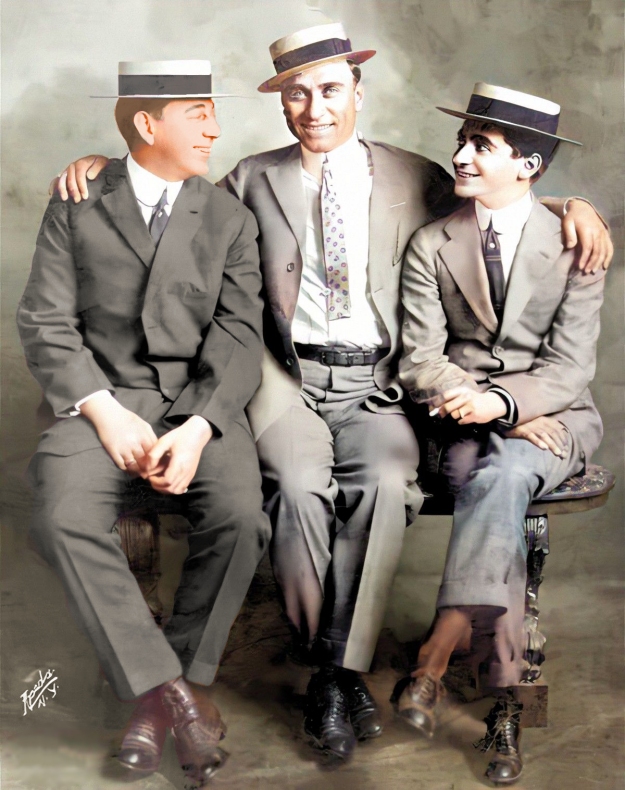 |
With the publication in 1911 of Alexander's Ragtime Band, Berlin's work provided enough publicity and income for the company that Snyder and Waterson found themselves in the position of having to pay Irving more royalties than they were comfortable with. Yet the pair needed to show gratitude to the young genius so as to keep his considerable talent within the fold. So Waterson re-incorporated the company with Berlin to form Waterson, Berlin & Snyder. Their office was above the famed Strand Theater in Manhattan. Ed Rose left the firm at that time, possibly feeling a bit crowded out by the increasing influx of new talent.
As it turns out, 1911 was a troublesome year for other reasons as well. One incident actually went largely unnoticed for nearly 80 years, in fact. After the release of Alexander's Ragtime Band, there was a notice in a New York paper that composer Scott Joplin was looking to have a word with Mr. Berlin. As it turns out, Joplin had been shopping his opera Treemonisha to various publishers, and it is very likely it ended up on the desk of the firm's prime composer for evaluation. While Waterson, Berlin & Snyder eventually returned the manuscript, there seems to be some historical concurrence that Berlin had the finale of the opera stuck in his head. The end result was that the verse of Alexander's Ragtime Band had many similarities to Joplin's A Real Slow Drag, but times being what they were in society, a plagiarism suit appears to have never been filed. Joplin reportedly altered his melody slightly to distinguish it from Berlin's big hit.
Another issue, one that took several years to resolve, had to do with contracts and rights. Publisher Charles K. Harris brought a suit against Ted Snyder, which was continued against the re-formed company, alleging that they had the publishing rights to song There's a Girl in Havana by E. Ray Goetz and Alfred Baldwin Sloane. Harris reportedly had the exclusive rights to publish music from the Lew Fields' production The Never Homes in which the song was interpolated. However, the composers chose to take it to Snyder. It became a benchmark case for distinguishing the differences of binding rights in the increasingly lucrative publishing world, deciding if composers could act individually in placing their works when an alternate contract vehicle was in place. Goetz and Sloane purported that the piece was written by other composers contracted with Snyder. Harris ultimately won the case in 1914, and Snyder was denied an appeal in 1915.
In spite of Berlin's mounting success, a notice for a 1912 concert in Reading, Pennsylvania gives Snyder the due consideration by stating that "Ted Snyder's popular hits, embracing the best selections of the New York composer and publisher, were probably the most relished selections on the programme. The feature songs from several of the latest music comedies were given." The two also worked together as a performing team, as noted in a December 1912 review of an advertising club meeting: "... A feature of the dinner was a cabaret performance. Irving Berlin, composer of popular songs, accompanied by Ted Snyder, another composer, at the piano, sang several of his own compositions, in some of which Snyder had collaborated..."
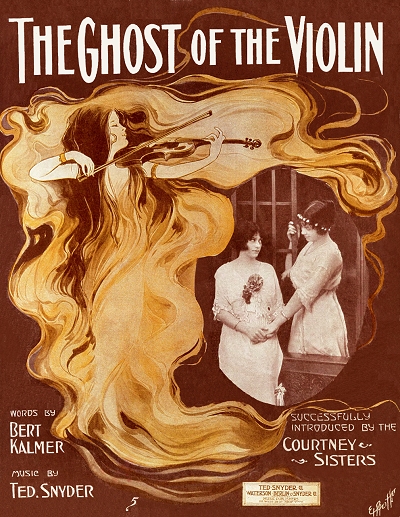 Snyder did align himself with a number of other lyricists outside of his time with Berlin, looking less perhaps for a hit song than just having a consistent output of material for the public to purchase. As was often the case, he would team some of his staff or contract writers with each other to see what they turned up, and in some cases there were some minor successes, and in others the two (or three) might not click, and nothing came out of the collaboration. Among those that Snyder wrote his own pieces include Bert Kalmar and Harry Ruby, who would eventually form their own formidable songwriting team. Among his long-time mainstays were Joe Young and Sam M. Lewis, who gave text to a number of hits in the Snyder catalog.
Snyder did align himself with a number of other lyricists outside of his time with Berlin, looking less perhaps for a hit song than just having a consistent output of material for the public to purchase. As was often the case, he would team some of his staff or contract writers with each other to see what they turned up, and in some cases there were some minor successes, and in others the two (or three) might not click, and nothing came out of the collaboration. Among those that Snyder wrote his own pieces include Bert Kalmar and Harry Ruby, who would eventually form their own formidable songwriting team. Among his long-time mainstays were Joe Young and Sam M. Lewis, who gave text to a number of hits in the Snyder catalog.His influence and gravitas were made clear in May 1914 when the theater district had a "Ted Snyder Week," featuring songs from his catalog, and appearances by the composer himself. As described in the New York Clipper on May 16, under the heading of Ted Snyder Night a Howling Success: "Ted Snyder night at Marcus Loew's Avenue B Theater last Wednesday night was the biggest success that anyone anticipated. The theater was crowded to the front doors. Several hundred were unable to obtain admission. Ted Snyder had about one dozen well known writers and singers on hand, and the affair wound up in a blaze of glory when Snyder himself was introduced and brought on his 'Eight Soldiers Singing On to Mexico.' A slide showing the American flag was thrown on the screen and a storm of applause swept over the house... It was a big night all around for Ted Snyder."
New York City was a highly competitive market, and through a combination of volume and the best possible quality, much of that from Berlin for a time, Snyder was able to maintain second or third place from time to time behind the enormous Jerome H. Remick Publishing Company, with a large presence in Manhattan in spite of it being based in Detroit, Michigan. Yet in league with many of his peers, Ted was not only a charter member of, but a driving force behind the formation ASCAP, founded in 1914. He and the co-founder, composer Victor Herbert, were active as the society's biggest supporters for many years.
Whether Ted saw himself as more of a business man or a musician is not at issue. However, his own role in his company was a matter of curiosity in a New York Clipper article in June 1916, partially excerpted here:
It is a paradox of the music business that places Ted Snyder's name in the junior partner section of the firm styled Waterson, Berlin & Snyder. For to the general public the name of Waterson is comparatively unknown; that of Berlin famed as a song writer only; whereas the name Ted Snyder is stamped indelibly on the popular mind. This in spite of the fact that Berlin's a fame-flash of successive hits, and Waterson's sagacity in financially backing them in such a way that they speedily became hits led to a change in firm style on the part of the concern that had previously been known as the Ted Snyder Co.
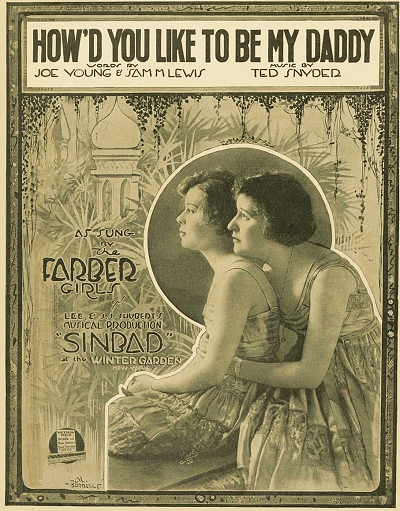 Waterson deserves all credit for his business acumen. Berlin stands at the very apex of popularity as a lyricist-composer, and yet it may be deemed a crowning tribute to lasting popularity to realize that performers seldom, if ever, refer to the firm as Waterson, Berlin & Snyder, but usually say "Let's go over to Snyders."
Waterson deserves all credit for his business acumen. Berlin stands at the very apex of popularity as a lyricist-composer, and yet it may be deemed a crowning tribute to lasting popularity to realize that performers seldom, if ever, refer to the firm as Waterson, Berlin & Snyder, but usually say "Let's go over to Snyders."Ted Snyder is a gentleman. You realize the fact that you are in good company the moment you enter upon a conversation with him. It may be true that Waterson originally found him pounding the keys in bazaar neighborhoods, but, if Ted ever had anything in common with the life of which he then formed a part, he has evidently completely outgrown its influence. He impresses you as the kind of a man who makes the most irregular existence in the world (that forced upon one popularizing songs) adhere to some sort of regularity. For he could not possess that steady eye, that breezy way of handling his correspondences, and that ability to appear at ease to worth-while visitors unless he made the most of the hours dedicated to slumber in a night greatly curtailed of it...
To-day, if you talk to Ted, he will say nothing about his own part in the development of modern music, but will tell you that Irving Berlin, unassisted, was responsible for the revolution in melody construction.
Snyder listed the Strand Theater address on his 1918 draft record, and his occupation as music publisher. At that time he was living at the New York Athletic Club in Manhattan. In early 1919 Berlin left the firm and formed his own company while retaining some ownership interest in the collaborative company. He continued on a brilliant career as both a publisher and composer that lasted over 6 decades. Berlin maintained his interest in Snyder's firm for several years. Snyder continued to work on stage and for special shows as well, even accompanying singer Al Jolson from time to time.
In 1919 Ted managed to get a show headed towards Broadway with the prohibition-themed The Water's Fine, originally titled Raising the Aunty. It had a book by writer Glen MacDonough, and starred veteran performer May Irwin. The production was a musical version of Sister Mary, a show that Irwin had previously worked in. In spite of good reviews in many papers, it closed while still on the road, never actually making it to the "great white way."
In the 1920 census Ted was shown living in two places at once. One was allegedly in Santa Monica, California on January 3, with Hope listed as in the home. It may have been a coincidence since he and Hope were no longer living together, but the ages and origins match well enough, and it shows that Theodore Snyder was running or working in a music store. The other listing, which was likely more current, was taken four days later on January 7, and shows Ted living in Manhattan on East 36th Street, listed as a music publisher, with composing was not mentioned. There are a number of possibilities to account for these multiple listings.
Hope had petitioned for legal separation from Ted in early 1916 on the grounds of abandonment, and he had been paying her alimony since that time. He had spent several months in Chicago in 1915 and when she asked to join him he wrote back saying "It is not advisable."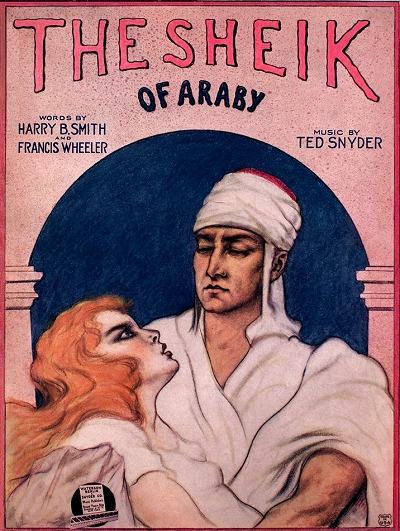 When he cut her allowance and she asked for more, he suggested that she go into the movies to make money. It became clear to her that Snyder was having an affair at that time. Hope eventually sued for a divorce, which was either granted or announced on June 28th, 1920. The complaint showed that she now considered herself to be a "movie actress," but records supporting any roles she played were difficult to locate. Another "movie actress" named Marie (with inevitable references in the media to the recent song hit Oh What A Pal Was Mary), was named as a co-respondent in the action. The timing of this action may be a bit suspect as the census, taken on January 7, shows him cohabitating with Marie Audrey (Farley) as his wife. It is likely that Hope, who would have moved near Hollywood to pursue acting in films, was living in Santa Monica and listed Ted due to what she felt was a legal obligation. Perhaps as a result of stress from the pending divorce and other factors, in March Ted suffered from a bout of appendicitis, and spent several weeks at home recovering from the surgery.
When he cut her allowance and she asked for more, he suggested that she go into the movies to make money. It became clear to her that Snyder was having an affair at that time. Hope eventually sued for a divorce, which was either granted or announced on June 28th, 1920. The complaint showed that she now considered herself to be a "movie actress," but records supporting any roles she played were difficult to locate. Another "movie actress" named Marie (with inevitable references in the media to the recent song hit Oh What A Pal Was Mary), was named as a co-respondent in the action. The timing of this action may be a bit suspect as the census, taken on January 7, shows him cohabitating with Marie Audrey (Farley) as his wife. It is likely that Hope, who would have moved near Hollywood to pursue acting in films, was living in Santa Monica and listed Ted due to what she felt was a legal obligation. Perhaps as a result of stress from the pending divorce and other factors, in March Ted suffered from a bout of appendicitis, and spent several weeks at home recovering from the surgery.
 When he cut her allowance and she asked for more, he suggested that she go into the movies to make money. It became clear to her that Snyder was having an affair at that time. Hope eventually sued for a divorce, which was either granted or announced on June 28th, 1920. The complaint showed that she now considered herself to be a "movie actress," but records supporting any roles she played were difficult to locate. Another "movie actress" named Marie (with inevitable references in the media to the recent song hit Oh What A Pal Was Mary), was named as a co-respondent in the action. The timing of this action may be a bit suspect as the census, taken on January 7, shows him cohabitating with Marie Audrey (Farley) as his wife. It is likely that Hope, who would have moved near Hollywood to pursue acting in films, was living in Santa Monica and listed Ted due to what she felt was a legal obligation. Perhaps as a result of stress from the pending divorce and other factors, in March Ted suffered from a bout of appendicitis, and spent several weeks at home recovering from the surgery.
When he cut her allowance and she asked for more, he suggested that she go into the movies to make money. It became clear to her that Snyder was having an affair at that time. Hope eventually sued for a divorce, which was either granted or announced on June 28th, 1920. The complaint showed that she now considered herself to be a "movie actress," but records supporting any roles she played were difficult to locate. Another "movie actress" named Marie (with inevitable references in the media to the recent song hit Oh What A Pal Was Mary), was named as a co-respondent in the action. The timing of this action may be a bit suspect as the census, taken on January 7, shows him cohabitating with Marie Audrey (Farley) as his wife. It is likely that Hope, who would have moved near Hollywood to pursue acting in films, was living in Santa Monica and listed Ted due to what she felt was a legal obligation. Perhaps as a result of stress from the pending divorce and other factors, in March Ted suffered from a bout of appendicitis, and spent several weeks at home recovering from the surgery.Ted's penultimate major hit from this time started out as a catchy tune headed in a different direction from where it ended up, as the title Rose of Araby from 1921 might suggest. He was happy with the chorus, but having trouble with the verse, an element he believed was fundamental to a song if it was strongly constructed. A partner convinced Snyder that he should alter the song lyrics to associate itself with the recent best-selling book, The Sheik. So with some help it was rewritten as The Sheik of Araby, and released just as the news that the book would be made into a movie starring the mysterious Rudolph Valentino became public knowledge. Such publicity did nothing but boost the song, which was all the rage when the Valentino craze swept the United States. The song was a big hit on piano rolls and records which sold a lot of sheet music as well. Even The Beatles recorded it forty years later having a little fun with it at that. While it obviously was never included on a soundtrack for the film, which lacked one during the silent era, Snyder would sometimes hire boys to sing the song to an off-stage piano accompaniment during certain scenes. He also wrote two other pieces to coincide with the career of the tragic Valentino, including You Gave Me Your Heart for Blood and Sand and That Night in Araby for the inevitable sequel, The Son of the Sheik.
In June 1922, Snyder, who had been a presence in Chicago from a distance, opened a large music emporium in that city. His Song Shop had been doing business since he obtained the building in 1921, but was undergoing many changes in advance of their eventual grand opening. It was considered to be a model establishment by the Music Trade Review as reported in their July 8 edition:
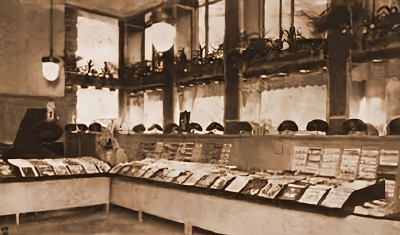 |
...The fact is, we have got so much to tell about Ted Snyder's new song shop that we don't know where to begin, and we can assure dealers who read this article that if they will apply just a little bit of the enthusiasm cited in our story their sales will show a marked increase...
There are many features which contribute to its success. The store boasts a silver-dollar floor, which brings many curiosity seekers who afterward become purchasers. This silver-floor idea was thought up by Ted Snyder as something similar to the waterfall staircase in the Crystal Palace of New York, where patrons of this establishment walk upstairs on glass steps underneath which is constantly flowing a stream of water. This, however, is only one of the novel features of Ted Snyder's Song Shop. The window displays each week are famous in themselves. For instance, the second week of the opening was devoted to "Sapphire Sea," illustrated by a large gold-fish aquarium, in which a blue electric bulb set off the brilliant hues of the goldfish. A base of sand and a tropical setting further enhanced the display. The third week "Dancing Fool" was featured. The window was painted to appear as though a brick had been hurled at it; in fact, the brick itself lay in the window just in front of the song in large letters, "Song Hit Here," and the boxing gloves of Benny Leonard, with which he won the championship, were shown as a further inducement for passers-by to pause and gape at this bellicose display. These three are just a sample of the winning windows appearing in Ted Snyder's Song Shop each week. Here is real, live, aggressive merchandising of a nature calculated to win sales...
The store became legendary, and references were made to the "glory days" of Snyder's Song Shop at State and Monroe well into the 1950s, long after it had shut down. Also through his Song Shop, Ted briefly entered the recording business as a jobber. They were responsible for the distribution of the Cameo Records line from 1922 to at least 1926. Henry Waterson, who had previously been involved with Little Wonder Records, was the vice president of the newly formed Cameo firm, becoming the president in 1925. Their biggest outlet was the Macy's department store chain. The first issue from the Cameo catalog in February 1922 was #200 by the Velvetone Dance Orchestra, and it just happened to be The Sheik of Araby.
Ted's final hit, composed in 1923, was the enormously successful Who's Sorry Now, composed with Bert Kalmar and Harry Ruby, a piece that endures into the 21st century. While it took over two decades to gain any serious traction, the piece was made famous in part by Lisette Verea in the 1946 Marx Brothers movie A Night in Casablanca,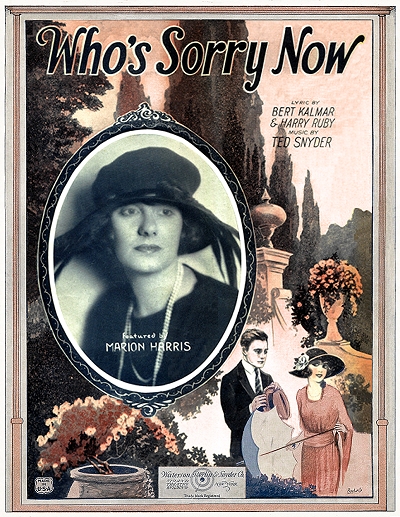 then even more so through the recording by 1950s starlet Connie Francis. The song's legacy in the public as well as in the courts lived at least into the late 1990s. A dispute emerged after the enactment of the 1976 copyright act, which had a provision to extend copyrights beyond the previous 56 year lifetime initially set in by 1906 copyright act. Snyder's wife and oldest son terminated the grant of copyright to Mills Music under the new law, but Mills insisted that it was still entitled to a share of mechanical royalties on any work (recordings, films, piano rolls, etc.) completed before the termination on January 3, 1980. The amount of money in dispute at that time was rather small at $1,343.41 for over 400 licenses, but for Mills, and the arbitrating representative, Harry Fox, it was a matter of principle. In essence, the decision would have an impact on thousands of hit songs composed from the late 1910s forward. The final decision was not made until January 8, 1985, by the United States Court of Appeals for the Second Circuit. In the end, Ted's family and the families of composers everywhere who were re-obtaining copyrights were not sorry, as Who's Sorry Now and all of the royalties from recordings and "derivative works" of the piece were conveyed with the copyright ownership. The argument was that the copyright laws were designed for the benefit of the composers and artists, so their decision, reversing an earlier decision partially in favor of Mills and Fox, had a positive impact on all copyright owners. Their rights were further extended under the so-called Bono/Disney copyright law of 1998, in which Who's Sorry Now also played a role due to the 1985 decision.
then even more so through the recording by 1950s starlet Connie Francis. The song's legacy in the public as well as in the courts lived at least into the late 1990s. A dispute emerged after the enactment of the 1976 copyright act, which had a provision to extend copyrights beyond the previous 56 year lifetime initially set in by 1906 copyright act. Snyder's wife and oldest son terminated the grant of copyright to Mills Music under the new law, but Mills insisted that it was still entitled to a share of mechanical royalties on any work (recordings, films, piano rolls, etc.) completed before the termination on January 3, 1980. The amount of money in dispute at that time was rather small at $1,343.41 for over 400 licenses, but for Mills, and the arbitrating representative, Harry Fox, it was a matter of principle. In essence, the decision would have an impact on thousands of hit songs composed from the late 1910s forward. The final decision was not made until January 8, 1985, by the United States Court of Appeals for the Second Circuit. In the end, Ted's family and the families of composers everywhere who were re-obtaining copyrights were not sorry, as Who's Sorry Now and all of the royalties from recordings and "derivative works" of the piece were conveyed with the copyright ownership. The argument was that the copyright laws were designed for the benefit of the composers and artists, so their decision, reversing an earlier decision partially in favor of Mills and Fox, had a positive impact on all copyright owners. Their rights were further extended under the so-called Bono/Disney copyright law of 1998, in which Who's Sorry Now also played a role due to the 1985 decision.
 then even more so through the recording by 1950s starlet Connie Francis. The song's legacy in the public as well as in the courts lived at least into the late 1990s. A dispute emerged after the enactment of the 1976 copyright act, which had a provision to extend copyrights beyond the previous 56 year lifetime initially set in by 1906 copyright act. Snyder's wife and oldest son terminated the grant of copyright to Mills Music under the new law, but Mills insisted that it was still entitled to a share of mechanical royalties on any work (recordings, films, piano rolls, etc.) completed before the termination on January 3, 1980. The amount of money in dispute at that time was rather small at $1,343.41 for over 400 licenses, but for Mills, and the arbitrating representative, Harry Fox, it was a matter of principle. In essence, the decision would have an impact on thousands of hit songs composed from the late 1910s forward. The final decision was not made until January 8, 1985, by the United States Court of Appeals for the Second Circuit. In the end, Ted's family and the families of composers everywhere who were re-obtaining copyrights were not sorry, as Who's Sorry Now and all of the royalties from recordings and "derivative works" of the piece were conveyed with the copyright ownership. The argument was that the copyright laws were designed for the benefit of the composers and artists, so their decision, reversing an earlier decision partially in favor of Mills and Fox, had a positive impact on all copyright owners. Their rights were further extended under the so-called Bono/Disney copyright law of 1998, in which Who's Sorry Now also played a role due to the 1985 decision.
then even more so through the recording by 1950s starlet Connie Francis. The song's legacy in the public as well as in the courts lived at least into the late 1990s. A dispute emerged after the enactment of the 1976 copyright act, which had a provision to extend copyrights beyond the previous 56 year lifetime initially set in by 1906 copyright act. Snyder's wife and oldest son terminated the grant of copyright to Mills Music under the new law, but Mills insisted that it was still entitled to a share of mechanical royalties on any work (recordings, films, piano rolls, etc.) completed before the termination on January 3, 1980. The amount of money in dispute at that time was rather small at $1,343.41 for over 400 licenses, but for Mills, and the arbitrating representative, Harry Fox, it was a matter of principle. In essence, the decision would have an impact on thousands of hit songs composed from the late 1910s forward. The final decision was not made until January 8, 1985, by the United States Court of Appeals for the Second Circuit. In the end, Ted's family and the families of composers everywhere who were re-obtaining copyrights were not sorry, as Who's Sorry Now and all of the royalties from recordings and "derivative works" of the piece were conveyed with the copyright ownership. The argument was that the copyright laws were designed for the benefit of the composers and artists, so their decision, reversing an earlier decision partially in favor of Mills and Fox, had a positive impact on all copyright owners. Their rights were further extended under the so-called Bono/Disney copyright law of 1998, in which Who's Sorry Now also played a role due to the 1985 decision.Hoping to get something on Broadway in a time where there were more theaters than ever and attendance was high, Ted teamed with Harry B. Smith to write the songs for the revue Fashions of 1924. However, the fashions never even made it out of the month of July in 1923, running only 13 performances. Snyder never wrote specifically for Broadway again, but a couple of his pieces did make it into revues later in the 1920s. Ted spent some time as a performer again, often heard on the radio in New York City between 1923 and 1928. For a time Snyder also fronted a studio group, Ted Snyder and his All Star Band.
In May 1928, Ted formally resigned from Waterson, Berlin & Snyder, leaving only Henry Waterson as a member of the firm. It would soon disappear in the wake of movie studio buyouts, much as the Jerome H. Remick company did during that same period. In January 1929, he opened a new publishing firm at 1650 Broadway in New York, but it did not last very long. Ted then followed the siren call heard by many East Coast composers that year as movie musicals were clearly in vogue, and abandoned New York for California in late 1929, never looking back.
As of the 1930 census, Ted was shown as living at 1250 S. Holt Avenue in Los Angeles, just outside of Beverly Hills, with Marie. Even though he was nearly done with it, he still listed his occupation as a song writer. Hope was still living in Santa Monica, but now working as a private practical nurse. One of Ted's first big projects was composing songs and incidental music for The Temptations of 1930, which debuted in Los Angeles at the Mayan Theater in October. This appears to have been his last work for live theater, and only one piece from the show was ultimately published.
At some point in the 1930s Marie gave birth to both of the couple's children, Theodore F. Snyder Jr. and Paul Snyder. From 1930 to 1932 his output with various lyricists would be only six songs, mostly for films, after which he retired on his publishing earnings and royalties. The Sheik of Araby and Who's Sorry Now alone helped the couple live comfortably. That income was supplemented by some syndicated West Coast radio work as well. Snyder lived his remaining years in California as a restaurateur and nightclub owner, having started with his café for artists and composers in 1936, located in Hollywood on the famous Sunset Strip. Preson Sturges reportedly favored this hangout. Snyder sold it for a profit in 1939. He also occasionally did some behind the scenes work with movie studios, much of it sadly uncredited today. As of the 1940 census, Ted, Marie, Theodore and Paul were living in Hollywood just off Sunset Blvd., with Ted listed as a song writer at home.
Snyder lived the final years of his life in Woodland Hills, California in the San Fernando Valley. Theodore Snyder died from complications following an abdominal surgery on July 12, 1965, leaving behind his widow and two sons. He was buried in the Oakwood Park Memorial Park Cemetery in nearby Chatsworth. Marie moved out to the desert area of Riverside, California, with one of her children, then followed Ted in March of 1981. In 1969, composer Johnny Mercer and composer/publishers Abe Olman and Howie Richmond founded the Songwriters Hall of Fame, with Snyder being one of the first composers inducted the following year.